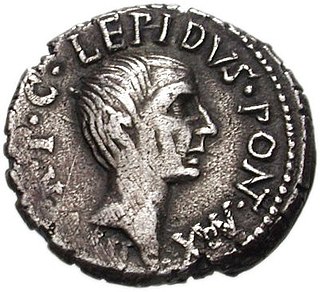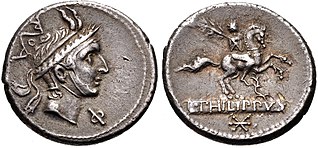
This article concerns the period 49 BC – 40 BC.
This article concerns the period 69 BC – 60 BC.
This article concerns the period 79 BC – 70 BC.
Year 40 BC was either a common year starting on Thursday, Friday or Saturday or a leap year starting on Thursday or Friday of the Julian calendar and a common year starting on Friday of the Proleptic Julian calendar. At the time, it was known as the Year of the Consulship of Calvinus and Pollio. The denomination 40 BC for this year has been used since the early medieval period, when the Anno Domini calendar era became the prevalent method in Europe for naming years.
Year 46 BC was the last year of the pre-Julian Roman calendar. At the time, it was known as the Year of the Consulship of Caesar and Lepidus. The denomination 46 BC for this year has been used since the early medieval period, when the Anno Domini calendar era became the prevalent method in Europe for naming years.
Year 13 BC was either a common year starting on Friday, Saturday or Sunday or a leap year starting on Friday or Saturday of the Julian calendar and a leap year starting on Wednesday of the Proleptic Julian calendar. At the time, it was known as the Year of the Consulship of Nero and Varus. The denomination 13 BC for this year has been used since the early medieval period, when the Anno Domini calendar era became the prevalent method in Europe for naming years.
Year 66 BC was a year of the pre-Julian Roman calendar. At the time it was known as the Year of the Consulship of Lepidus and Tullus. The denomination 66 BC for this year has been used since the early medieval period, when the Anno Domini calendar era became the prevalent method in Europe for naming years.

Year 216 BC was a year of the pre-Julian Roman calendar. At the time it was known as the Year of the Consulship of Varro and Paullus. The denomination 216 BC for this year has been used since the early medieval period, when the Anno Domini calendar era became the prevalent method in Europe for naming years.
Year 179 BC was a year of the pre-Julian Roman calendar. At the time it was known as the Year of the Consulship of Flaccus and Fulvianus. The denomination 179 BC for this year has been used since the early medieval period, when the Anno Domini calendar era became the prevalent method in Europe for naming years.

Marcus Aemilius Lepidus was a Roman general and statesman who formed the Second Triumvirate alongside Octavian and Mark Antony during the final years of the Roman Republic. Lepidus had previously been a close ally of Julius Caesar. He was also the last pontifex maximus before the Roman Empire, and (presumably) the last interrex and magister equitum to hold military command.

The gens Aemilia, originally written Aimilia, was one of the greatest patrician families at ancient Rome. The gens was of great antiquity, and claimed descent from Numa Pompilius, the second King of Rome. Its members held the highest offices of the state, from the early decades of the Republic to imperial times. The Aemilii were almost certainly one of the gentes maiores, the most important of the patrician families. Their name was associated with three major roads, an administrative region of Italy, and the Basilica Aemilia at Rome.

Lucius Aemilius Paullus was a Roman politician. He was the brother of triumvir Marcus Aemilius Lepidus and son to Marcus Aemilius Lepidus the consul of 78 BC. His mother may have been a daughter of Lucius Appuleius Saturninus.
Marcus Aemilius Lepidus was a Roman statesman and general. After the death of Lucius Cornelius Sulla, he joined or instigated a rebellion against the Sullan regime, demanding a consecutive term as consul late in his year and, when refused, marching on Rome. Lepidus' forces were defeated in a battle near the Milvian Bridge and he fled to Sardinia. He was the father of the triumvir Lepidus and of the Lucius Aemilius Lepidus Paullus who was consul in 50 BC.

Lucius Marcius Philippus was a Roman orator and an important politician of the late Roman Republic.
Marcus PerpernaVeiento was a Roman aristocrat, statesman and general. He fought in Sulla's civil war, Lepidus' failed rebellion of 77 BC and from 76 to 72 BC in the Sertorian War. He conspired against and assassinated Quintus Sertorius, and was defeated and executed by Pompey the Great.
Mamercus Aemilius Lepidus Livianus was a Roman politician and military commander who was consul in 77 BC.
Quintus Lutatius Catulus Capitolinus was a politician in the late Roman Republic. His father was the like-named Quintus Lutatius Catulus, consul in 102 BC. He gained the agnomen "Capitolinus" for his defense of the capital in 77 BC against Lepidus.
Marcus Junius Brutus was a plebeian tribune of the Roman Republic in 83 BC and the founder of the colony in Capua. He was an associate of Marcus Aemilius Lepidus, who led a revolt against the senate after the death of Sulla. He was captured by Pompey and treacherously executed. He was the father of a homonymous son, who assassinated Julius Caesar in 44.
Quintus Aemilius Lepidus was a Roman senator and military officer who was appointed consul in 21 BC as the colleague of Marcus Lollius.






